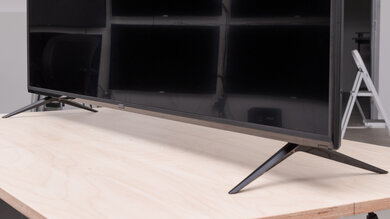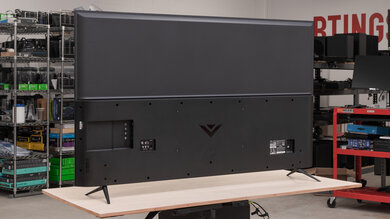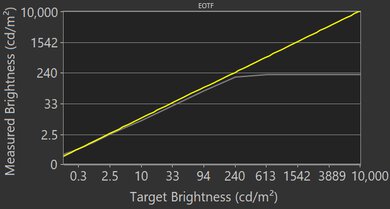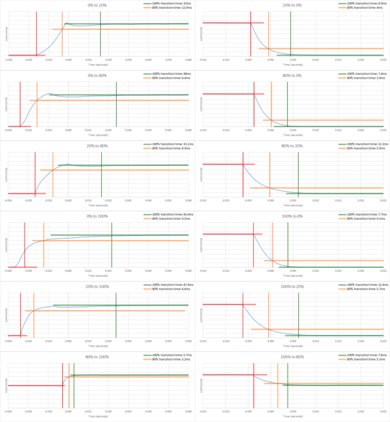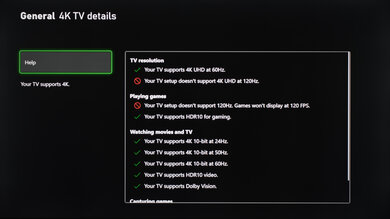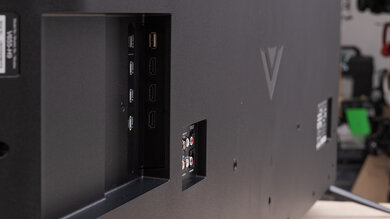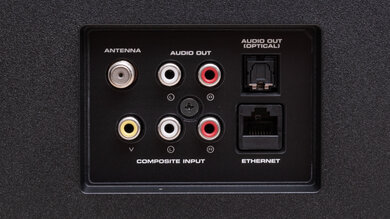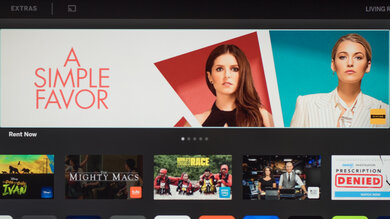The Vizio V Series 2020 is an entry-level 4k TV that Vizio released in 2020. It sits below the Vizio M7 Series Quantum 2020 and it replaces the Vizio V Series 2019. It's a rather simple TV that's available in a wide range of sizes, from 40 to 75 inches, and all of them are available with the same features and similar performance. Like all Vizio TVs, it comes with the SmartCast operating system built-in, which isn't the best operating system available because it's laggy and you can't download any extra apps besides the pre-installed ones, but it supports Google Chromecast and Apple AirPlay so that you can easily cast content from your phone.
Our Verdict
The Vizio V Series is okay for most uses. Its exceptionally low input lag makes it an okay choice for gaming and a decent TV for use as a PC monitor. However, it has a mediocre response time that makes motion look blurry, which isn't ideal for fast-paced games or for watching sports. It's okay for watching movies due to its high contrast ratio, but it doesn't display a wide range of colors in HDR and doesn't make highlights pop, so its overall HDR performance isn't that good. It's adequate for watching TV shows, but it doesn't perform well in bright rooms with wide seating areas.
- Excellent contrast ratio.
- Good reflection handling.
- Doesn't get very bright.
- Poor viewing angles.
The Vizio V Series is okay for watching movies. It's well-suited for dark room viewing due to its high contrast ratio and impressive black uniformity, but it doesn't have a local dimming feature to improve black levels further. It removes judder from 24p sources and native apps, and it doesn't stutter much in lower frame rate content like movies.
- Excellent contrast ratio.
- Great black uniformity.
- No local dimming.
- Doesn't get very bright.
The Vizio V Series is adequate for watching TV shows. Even though it handles reflections well, it's better suited for dark rooms as it doesn't get bright enough to combat glare. Its narrow viewing angle makes images look washed out from the sides, so it isn't the best option if you watch shows in a wide seating area. The SmartCast interface doesn't have an app store, so you can't download any extra besides the pre-installed ones, but you can cast content from your phone to stream your favorite shows.
- Excellent contrast ratio.
- Good reflection handling.
- Doesn't get very bright.
- Poor viewing angles.
The Vizio V Series is mediocre for watching sports. It has a narrow viewing angle, which isn't ideal for wide seating areas as the image looks washed out from the sides. Even though it has good reflection handling, it doesn't get bright enough to overcome glare if you want to use it in a well-lit room. Its response time is a bit slow and causes motion blur in fast-moving scenes. Also, there's a fair amount of dirty screen effect which can get distracting during sports.
- Excellent contrast ratio.
- Good reflection handling.
- Doesn't get very bright.
- Mediocre response time.
- Poor viewing angles.
The Vizio V Series is an okay gaming TV. It has low input lag, ensuring a responsive gaming experience, but the response time is a bit slow, so fast-paced games tend to look very blurry. It also doesn't support any advanced gaming features, like variable refresh rate technology (VRR), and it's limited to a 60Hz refresh rate, so it can't display 120Hz signals from the latest consoles.
- Excellent contrast ratio.
- Low input lag.
- Great black uniformity.
- Doesn't get very bright.
- No VRR support.
- Mediocre response time.
The Vizio V Series is okay for watching movies in HDR. It produces deep blacks for a great dark room viewing experience, as it has a high contrast ratio and impressive black uniformity. Unfortunately, it lacks a local dimming feature, can't display a wide color gamut, and doesn't get bright enough to make highlights stand out, so its overall HDR experience isn't satisfying.
- Excellent contrast ratio.
- Great black uniformity.
- No local dimming.
- Doesn't get very bright.
The Vizio V Series is alright for gaming in HDR. It has low input lag, but its response time is mediocre, so motion looks blurry, and it doesn't support any variable refresh rate technology to reduce screen tearing. It doesn't display a wide color gamut and doesn't get bright enough to make highlights pop, so HDR content doesn't look much different from SDR.
- Excellent contrast ratio.
- Low input lag.
- Great black uniformity.
- No local dimming.
- Doesn't get very bright.
- No VRR support.
- Mediocre response time.
The Vizio V Series is alright for use as a PC monitor. It has low input lag, supports most common resolutions, and can display proper chroma 4:4:4 to help make text look clear. However, its mediocre response time causes more motion blur, and its narrow viewing angles makes the edges of the screen look inaccurate if you sit too close. It also doesn't get bright enough if you want to use it in a well-lit room.
- Excellent contrast ratio.
- Good reflection handling.
- Low input lag.
- Doesn't get very bright.
- Mediocre response time.
- Poor viewing angles.
Changelog
- Updated Oct 11, 2022: Added that the new Vizio V Series 2022 supports variable refresh rate technology.
- Updated Aug 04, 2022: Updated the review for clarity and accuracy.
- Updated Jul 26, 2021: We added two videos showing the backlight performance with real content. We also retested the HDMI ports to confirm that they don't support HDMI 2.1.
- Updated Jul 12, 2021: Updated review for accuracy and clarity.
Check Price
Differences Between Sizes And Variants
We tested the 65-inch 2020 Vizio V Series (Vizio V655-H9), and for the most part, we expect our results to be valid for the 40-inch (Vizio V405-H9), 43-inch (Vizio V435-H1), 50-inch (Vizio V505-H9), 55-inch (Vizio V555-H1), 58-inch (Vizio V585-H11), 60-inch (Vizio V605-H3), 70-inch (Vizio V705-H1), and 75-inch (Vizio V755-H4) versions. The model codes also vary per retailer, so the table below includes alternative codes for each size.
| Size | Model(s) |
|---|---|
| 40" | V405-H9, V405-H19 |
| 43" | V435-H1, V35-H11 |
| 50" | V505-H9, V505-H19 |
| 55" | V555-H1, V555-H11 |
| 58" | V585-H11 |
| 60" | V605-H3 |
| 65" | V655-H4, V655-H9, V655-H19 |
| 70" | V705-H1, V705-H3, V705-H13 |
| 75" | V755-H4, V755-H14 |
If someone comes across a different type of panel or if their Vizio V Series doesn't correspond to our review, let us know and we will update the review. Note that some tests, like gray uniformity, can vary between individual units.
You can see our unit's label here.
Popular TV Comparisons
The Vizio V Series is an okay budget TV. It performs well for a cheap TV, but there are some drawbacks as its smart system isn't as good as on other TVs, and you can get brighter displays if you're willing to spend just a bit more.
Also check out our recommendations for the best budget TVs, the best TVs under $500, and the best smart TVs.
The Vizio V Series 2022 is a newer version of the Vizio V Series 2020. The 2022 model improves in a few areas, like peak brightness, motion handling, and color accuracy, and it has a few extra features like VRR support for gamers. Because of this, the 2022 model is the better choice as a budget-friendly TV.
The Vizio V Series is better than the Hisense H6570G for most uses. The Vizio has better reflection handling, significantly lower input lag, and better color accuracy out-of-the-box. However, the Hisense gets brighter in HDR, and it has a much quicker response time.
The Vizio V Series 2019 is marginally better than the Vizio V Series 2020. The 2019 has a higher contrast ratio, faster response time, and it gets a lot brighter. The 2020 has better reflection handling and much lower input lag.
The Vizio V Series 2020 and the TCL 4 Series 2019 are very similar. The Vizio has better reflection handling and color accuracy, and it gets brighter to combat glare. However, the TCL has a much faster response time and a higher native contrast ratio.

We buy and test dozens of TVs yearly, taking an objective, data-driven approach to deliver results you can trust. Our testing process is complex, with hundreds of individual tests that take over a week to complete. Most of our tests are done with specially designed test patterns that mimic real content, but we also use the same sources you have at home to ensure our results match the real-world experience. We use two main tools for our testing: a Colorimetry Research CR-100 colorimeter and a CR-250 spectroradiometer.
Test Results

The Vizio V Series' design is simple and looks almost identical to the Vizio V Series 2019. The borders are thin so they aren't distracting while watching content.
The back of the TV is plain. The top half is metal, while the bottom half is plastic. There's no cable management, and the inputs are hard to reach with it wall-mounted because some are back-facing and the others are side-facing but set into the TV.
The Vizio V Series has disappointing SDR peak brightness, and it isn't bright enough to overcome glare in a bright room. Fortunately, there's very little variation in peak brightness with different content.
These results are from after calibration in the 'Calibrated Dark' Picture Mode, with Gamma set to '2.2', and Color Temperature set to 'Warm'. If image accuracy isn't as important to you as peak brightness, the 'Bright' Picture mode is a bit brighter; however, the difference isn't really noticeable, as it only goes up to 226 cd/m² in the 50% window.
Although Vizio markets this TV as having a full-array backlight, it's just a direct-lit backlight, and it doesn't have a local dimming feature. The video is for reference only, so you can see how the backlighting compares to the backlighting on other TVs.
This TV doesn't have a local dimming feature. The video is for reference only, so you can see how the backlighting performs versus other TVs.
The HDR peak brightness is bad. It isn't bright enough for small specular highlights to stand out, resulting in a rather flat, dull image. The EOTF doesn't follow the target PQ curve well either, as dark scenes are darker than they should be, and there's a loss of fine details in most scenes due to the sharp roll-off at the peak brightness, which happens early.
These results are in the 'Calibrated Dark' Picture Mode, with Gamma set to 2.2, and Color Temperature set to 'Warm'.
If you find HDR content too dim, try setting the Picture Mode to 'Calibrated Dark', Gamma to '1.8', Color Temperature to 'Standard', Local Contrast to 'High', Backlight Control to 'On', and Black Detail to 'High'. This makes shadow details brighter, but it doesn't impact most scenes, as you can see in this EOTF, and it doesn't change the peak luminosity.
The HDR peak brightness is about the same in Game Mode as out of it. There's no noticeable difference and the settings used during testing are the same as outside of Game Mode, but with the Game Low Latency setting enabled.
The Vizio V Series has mediocre gray uniformity. There's vignetting at the corners and a fair amount of dirty screen effect in the center. This can get distracting while watching sports, and especially if you want to use it as a PC monitor.
The Vizio V Series has a poor viewing angle. The screen looks washed out when viewed from the sides, so it isn't ideal for large rooms with wide seating areas. If you need something with a wide viewing angle, then check out the LG UP7000.
The Vizio V Series has good reflection handling. The semi-gloss finish doesn't diffuse direct reflections very well, though, so bright lights can still be distracting. Since this TV can't get very bright, visibility is an issue in a bright environment, but it's fine in rooms with a few lamps around.
The Vizio V Series has good accuracy out of the box. The white balance is decent, but brighter shades of gray are a bit off. Colors are great for the most part, except for yellows. Gamma is pretty close to the 2.2 target for moderately-lit rooms, but bright scenes are over-brightened a bit.
After calibration to the D65 white point, the overall accuracy is incredible. It's easy to calibrate as the white balance is almost perfect, and the color temperature is almost spot-on with the 6500K target. Yellows are much better, and there are only a few inaccuracies with colors. Gamma is better, except that bright scenes are now too dark.
See the calibration settings here.
The Vizio V Series uses a BGR subpixel layout. While this doesn't affect picture quality, it negatively impacts how text is rendered when using the TV as a PC monitor, but there are workarounds. You can read more about it here.
The Vizio V Series has an okay color gamut. Coverage of the DCI-P3 color space used by most current HDR content is good, but it doesn't display the full range of any of the primary colors. Coverage of the wider Rec. 2020 color space is disappointing, so it's not very future-proof.
This TV has a mediocre color volume, mostly due to its lack of a wide color gamut. Saturated blues aren't very bright, and despite the high contrast ratio, it doesn't display saturated colors at low luminance levels very well.
The Vizio V Series has excellent gradient handling. There's only some minor banding in the greens and grays. Setting Contour Smoothing to 'High' removes most of it, but it can cause a loss of fine details in high-quality content.
We don't expect VA panels to experience permanent image retention, as the VA panel in our long-term test appears immune.
The Vizio V Series has a mediocre response time. Transitions in dark scenes are considerably slower than bright scenes, so there's a significant blur trail behind fast-moving objects in darker scenes. The backlight flicker also causes image duplications with fast-moving content.
This TV doesn't have an optional backlight strobing feature, but it flickers permanently at 480Hz at any backlight level below the maximum. This causes image duplication and there's no way to change it. The score is based on the flicker frequency and the fact that you can't change it, and not the actual performance.
The Vizio Series V doesn't have a motion interpolation feature.
Due to the TV's slower response time, there's very little stutter in lower frame content.
This TV can remove judder from 24p sources and native apps, but not from 60p/60i sources like most cable boxes.
This TV doesn't support any variable refresh rate technology to reduce screen tearing. If you want a TV that does support VRR, then check out the Vizio V Series 2022.
The Vizio V Series has very low input lag when gaming in Game Mode. You won't notice any delay, which is great for reaction-based games.
This TV supports most common resolutions at 60Hz and can display proper chroma 4:4:4 at 1080p and 4k, which is important for clear text. It can display an image in 1440p with chroma subsampling; however, it looks stretched out and fuzzy.
This TV only supports basic 4k @ 60Hz formats from the PS5 and Xbox Series as it doesn't have HDMI 2.1 bandwidth or VRR support. However, it does support Auto Low Latency Mode that automatically switches the TV into Game Mode for low input lag when you launch a game from a compatible device.
Although advertised to support HDMI 2.1, this TV is limited to HDMI 2.0 bandwidth.
The dedicated composite input is great if you have an old gaming console or any other device that requires this connection as not many modern TVs have it.
This TV supports eARC, allowing you to pass high-quality audio signals over an HDMI connection to a compatible receiver.
The frequency response is okay. It delivers dialogues clearly, but it noticeably lacks bass, so it doesn't produce a thumping or rumbling sound. It gets reasonably loud, and there isn't much compression when playing at max volume.
This TV has decent distortion performance. There's minimal distortion at moderate volume levels, but it increases at the max volume.
Vizio's SmartCast interface is decent. It's easy to use, but there are occasional bugs here and there. During testing, none of the apps opened until we restarted the TV through the settings menu. That said, we only had to do it once, and it worked fine after the reboot.
The remote has a circular navigation pad and a dedicated button to access Vizio's 'Watch Free' feature. It doesn't have a mic for voice control, but the replacement to this TV, the Vizio V5 Series 2021, has a new remote that does.


